#what are google algorithm updates
Explore tagged Tumblr posts
Text
Google constantly updates its search algorithm to improve user experience and provide the most relevant results. These updates range from minor tweaks to major changes that significantly impact website rankings. Google’s primary goal is to enhance search accuracy, combat spam, and prioritize high-quality content.
Key updates like Panda, Penguin, Hummingbird, RankBrain, BERT, and Helpful Content Update have reshaped SEO strategies over the years. In recent times, Google’s focus has shifted towards AI-driven search, E-E-A-T (Experience, Expertise, Authoritativeness, Trustworthiness), and Core Web Vitals for better page experience.
For SEOs and businesses, staying updated on algorithm changes is crucial to maintaining online visibility. Regularly monitoring Google Search Console, following SEO best practices, and focusing on user-centric content can help websites adapt effectively. As Google continues evolving, those who prioritize quality content, user experience, and ethical SEO strategies will stay ahead in the search game.
#digitalpreeyam#google algorithm update#google algorithm#google algorithm updates#google algorithm update 2023#google update#algorithm updates#google core update#what are google algorithm updates#list of google algorithm updates#google algorithm update 2024#google algorithm update 2022#google algorithm update 2021#how many google algorithm updates#latest google algorithm update#new google algorithm update 2021#instagram algorithm updates 2025#google search update
0 notes
Text
"The first satellite in a constellation designed specifically to locate wildfires early and precisely anywhere on the planet has now reached Earth's orbit, and it could forever change how we tackle unplanned infernos.
The FireSat constellation, which will consist of more than 50 satellites when it goes live, is the first of its kind that's purpose-built to detect and track fires. It's an initiative launched by nonprofit Earth Fire Alliance, which includes Google and Silicon Valley-based space services startup Muon Space as partners, among others.
According to Google, current satellite systems rely on low-resolution imagery and cover a particular area only once every 12 hours to spot significantly large wildfires spanning a couple of acres. FireSat, on the other hand, will be able to detect wildfires as small as 270 sq ft (25 sq m) – the size of a classroom – and deliver high-resolution visual updates every 20 minutes.
The FireSat project has only been in the works for less than a year and a half. The satellites are fitted with custom six-band multispectral infrared cameras, designed to capture imagery suitable for machine learning algorithms to accurately identify wildfires – differentiating them from misleading objects like smokestacks.
These algorithms look at an image from a particular location, and compare it with the last 1,000 times it was captured by the satellite's camera to determine if what it's seeing is indeed a wildfire. AI technology in the FireSat system also helps predict how a fire might spread; that can help firefighters make better decisions about how to control the flames safely and effectively.
This could go a long way towards preventing the immense destruction of forest habitats and urban areas, and the displacement of residents caused by wildfires each year. For reference, the deadly wildfires that raged across Los Angeles in January were estimated to have cuased more than $250 billion in damages.
Muon is currently developing three more satellites, which are set to launch next year. The entire constellation should be in orbit by 2030.
The FireSat effort isn't the only project to watch for wildfires from orbit. OroraTech launched its first wildfire-detection satellite – FOREST-1 – in 2022, followed by one more in 2023 and another earlier this year. The company tells us that another eight are due to go up toward the end of March."
-via March 18, 2025
#wildfire#wildfires#la wildfires#los angeles#ai#artificial intelligence#machine learning#satellite#natural disasters#good news#hope
722 notes
·
View notes
Text
THE AESTHETICS OF ABANDONWARE: WHY DEAD SOFTWARE FEELS HOLY
By R A Z, Queen of Glitches, Rat Prophet of the Post-Crash Pixel-Chapel
INTRO: Oi, you ever boot up a DOSBox emulator and feel your soul whisper "Amen"? No? Then saddle up, you absolute fetus, 'cause we’re going full pilgrimage through the haunted cathedrals of dead code, cursed shareware, and disc rot salvation. This is for the ones who dream in .BMPs, weep in MIDI, and hit “Yes to All” when copying cracked ZIPs from forgotten FTPs at 3AM. Abandonware ain’t just nostalgia—it’s digital necromancy. And some of us are bloody good at it.
DEAD SOFTWARE = HOLY SHRINE
Let’s be clear: abandonware is software that’s been, well, abandoned. The devs moved on. The publisher collapsed in a puff of VC smoke. The website's now a spammy shell selling beard oil or crack cocaine. The software? Unupdated. Unsupported. Gloriously obsolete.
So why does launching Hover! or Starship Titanic in 2025 feel like entering a chapel with weird lighting and a dial-up modem choir?
Because it’s sacred, mate.
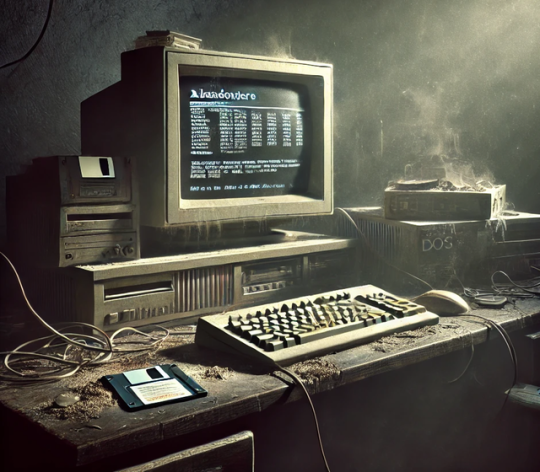
We’re not talking about the games themselves being perfect. A lot of them were janky as hell. We’re talking vibe. These programs exist outside capitalism now. They’re post-market. Post-hype. They don’t want your money, your updates, your logins. They just want your attention—pure and simple. You’re not a user anymore. You’re a curator. A digital monk brushing dust off EXEs and praying to the Gods of IRQ Conflicts and SoundBlaster settings.
WHY IT HITS DIFFERENT
Dead software doesn’t update. It doesn’t push patches or ads. It won’t ask you to connect your Google account to play Math Blaster. It’s a sealed time capsule. Booting it up is like receiving an artifact from a parallel dimension where the internet still had webrings and every kid thought Quake mods would lead to a dream job at ID Software.
But it also represents a lost sincerity. These weren’t games made to hook you for eternity with algorithms. These were games made by six dudes in a shed with a caffeine problem and one working CD burner. And their README files were poetry. Half of them end with “Contact us on AOL or send a floppy to our PO Box.” What do you mean you don’t know what a PO Box is?
FOR THE ZOOMIES: YOU JUST MISSED THE GOLDEN ROT
Listen up, juniors. If you were born after 2005, you missed the age when the internet was held together with chewing gum, JPEG artifacts, and unspoken respect.
Back then, finding a rare game was an adventure. Not an algorithm. You didn’t scroll TikTok and get spoon-fed vibes. You climbed through broken Geocities links and begged on IRC channels. You learned to read. You learned to search. You learned that “No-CD crack” doesn’t mean what your mum thinks it means.
So here’s your initiation: go download something weird from a forgotten archive. No guides. No Discord server. Just the raw, terrifying joy of not knowing if you’ve just installed Robot Workshop Deluxe or a Russian trojan. Welcome to the cult.
THE TWO-YEAR RULE
Online communities? They’re mayflies with usernames. Peak lifespan? Two years.
Here’s the cycle:
A niche game/tool/art style gets revived.
People form a forum/Reddit/Discord.
A zine or remix scene emerges.
Drama. Mods quit. Someone forks the project.
Everyone vanishes.
This cycle has always existed. The only difference now is that it’s faster. But dead software bypasses this. It’s post-community. You don’t have to join a scene. You are the scene. Every time you open it up, you’re plugging into a ghost socket. You’re chatting with echoes. It’s beautiful.
CONCLUSION: THIS IS A RELIGION NOW. PRACTICE IT.
Abandonware isn’t about gaming. It’s about reclaiming reverence. About saying “This mattered” even if no one else remembers it did. It’s about surfing the ruins, not for loot, but for meaning. There’s holiness in opening a program that hasn’t been touched in decades and seeing it still works. Still waits for you. Still loads that same intro MIDI with the confidence of a god.
So light a candle. Install a CRT filter. Screenshot that low-res menu and print it on a t-shirt. You’re not just playing with the past. You’re preserving the bones of the digital age.
See you in the BIOS, kids.
—
RAZ out.
#abandonware#digitalnostalgia#deadsoftware#softwaregraveyard#forgottenweb#vaportech#cyberrelics#dataisreligion#glitchaesthetic#dosgames#earlyinternet#webringculture#digitaldecay#postironictech#crtcore#bitrot#retrocomputing#ghostsofthesoftmachine#hauntology#pixelmonastery#blessthisbootsector#prayingtomidifiles#worshiptheexe#floppydiskcult#exenetkidsunite#ripircchannels#poeticreadme#geocitiesforever#netlordforlife#internetarchaeology
50 notes
·
View notes
Text
A long long time ago, before we had apps and algorithms telling us what to listen to, it was sort of difficult to find new indie music to listen to. I become a follower of this guy I discovered online who would post monthly downloadable playlists of indie songs. This was mostly over the years 2008-2009. One month he had updated us that the playlists had to stop temporarily because he was going to jail (unclear if it was due to the music pirating which was possible back then). After a few months of silence I stopped checking for updates and never went back despite some of my all time favourite songs coming from these playlists.
It’s interesting in hindsight I guess to think about how much an internet stranger can shape a part of who you are as a person, over a decade later I still listen to songs I found on these playlists regularly.
In terms of internet space lingo we could call this curation, where a person with whom you can personally relate to will introduce you to new things in a related sense. and I’d like to add that they are not doing this for monetary gain/advertisement. Some people think with the death of google and the onslaught of algorithms that don’t really understand why they’re telling you to try certain things, that curation is due for a large scale revival. (Especially now with that new website substack that the younger kids are latching on to).
Anyways, I decided to look up the playlist and I found it’s still being produced to this day, Blalock’s Indie Rock Playlist;
birp.fm
28 notes
·
View notes
Text
we're on tumblr again yay✨

Hey everyone! And welcome to Snoozy Kazoo's first ✨TUMBLR DEVPOST!!✨ We'll be releasing these every month from now on as a way to keep everyone updated on Snoozy Kazoo news!
If you're new here, hi! We’re Snoozy Kazoo, a game dev studio of six guys who make dumb, silly, and fun games. You might know us from the games Turnip Boy Commits Tax Evasion and Turnip Boy Robs a Bank, available HERE and HERE!
Let's get caught up! In this issue we're covering a new mobile release, anniversaries, and... our NEW GAME? 😳😳😳
What's Snoozy been up to?
Ok I know what I said earlier, but let’s be honest: if you’ve stumbled deep into the mines enough to find your way here, you’re surely familiar with our beloved Turnip Boy. We just passed by his anniversary of robbing a bank on January 18th! Aww! They grow up so fast… But it’s a good thing he’s not robbing banks anymore, that’s a crime, you kn-
Aw crud he's doing it on your phone now
Snaps my fingers disappointingly. Aw man. Yerrrrp. Turnip Boy Robs a Bank is now on iOS and Android devices near you. His mindless yet fervent desire to wreck crime upon the world seems insatiable. It’s really unfortunate, except for the fact that it’s honestly really fun watching him go at it.
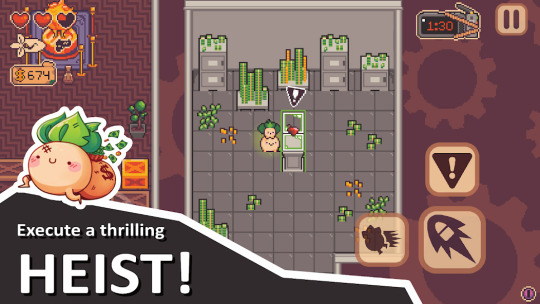
The game is available TODAY on the Apple App Store and Google Play Store! Re-experience the game or force your friends to — its fun either way!
Ahhh the beloved Turnip Boy. Surely your next game will be about him right?
Heehee nope!
Excitingly, in November, we announced our next game: Hobnobbers! A co-op mall-looter where you rob malls for your goddess!
youtube
If you haven’t already wishlisted the game yet, well… go wishlist it! Go make your friends wishlist it! Wishlist wishlist wishlist! It really helps us beat the Algorithm Overlords, so literally every single wishlist counts!
I already know about your little crow-gnome mall-looting game you do not shut up about it. What else is new?
We also released a new devlog over on our YouTube! We’ll be releasing one of these every few months, so make sure to subscribe!
youtube
In it, we’ve covered the game’s conception till its early development, which means a lot of concept art. Honestly, let’s toss a little bit more of it over here; it’s always exciting to see behind the curtain!

Now get ready for... 🥁🥁🥁

Woah! What’s this little place? Perhaps the chance to get to meet different members of the team and bombard them with questions to foster a parasocial relationship with them? No way!
Introducing… Alexis! Our Unreal Developer!
What are you most excited for in Hobnobbers?
I’m very excited for a lot of different technical aspects and seeing people’s reaction to the game! I want to see all of the systems come together to create a perfect storm of chaos. The randomly generated map ontop the hexes system, with events like Money Storms, Floods, and Fairy Circles of Doom, is going to make each run completely unique and you’ll never know what kind of madness you’re getting into! On launch day I intend to be hopping into games with people (and fixing any bugs that crop up).
What’s something you’ve worked on in Hobnobbers recently that you’ve found particularly frustrating?
The level generation for the mall has been a particular nightmare, but in a very fun way. The mall is generated from bottom-to-top and each floor tells the floor above it about the different combinations of rooms that it can generate. This allows us to have those iconic vertical levels that overlap eachother with walkways above the floors below! This has required a lot of tuning in both making the parts that generate, and how to place them to get results that are always interesting (without bugs). Not only do we have to generate each floor, we also have to generate each store! Accounting for the size and placement of these is a constant challenge when making segments but I made a blender template that speeds it up quite a lot.
What pitch did you end up bringing to the pitch competition?
My pitch was a game about a vampire who was ousted from their castle by another vampire, and is trying to take it back. You would have to sneak back in through various pathways that challenge you in different ways, some would require parkour skills, others would require puzzle solving. And while you’re doing all of this, the AI learns and adapts to your behavior setting traps or blocking off paths in a constant game of cat and mouse. I am still extremely passionate about this idea, and fully intend to pursue it one day!
Awesome! Thank you for your time! 😊
Okie dokie that’s a wrap for now
In future devposts, we’ll be including questions sent in by the community! Feel free to send them in over here on Tumblr, or join our Discord and ask questions in the “ask-the-devs-❓” channel!
See you soon!
— Kiki
#turnip boy#turnip boy commits tax evasion#turnip boy robs a bank#devlog#game dev#game development#indie game#indie dev#indie games#snoozy kazoo#devpost
34 notes
·
View notes
Text
The Brain’s Magic: How Your Mind Reads the ᵾᶰᴿᵋᴬᵭᵃᴮʟᵋ͟͟͞
Can You Still Call Yourself Human If You’re This F☰☰king Amazing?

Our brains are incredible biological machines that can decode the undecodable, make sense of chaos, and turn gibberish into understanding. You’ve probably seen those memes or tests where the letters in a sentence are jumbled, replaced with symbols, or entirely flipped. And yet, somehow, your mind calmly steps in and says, “I got this,” assembling the scrambled mess into meaning.
Why? Because your brain isn’t just functional—it’s damn near magical. But let’s get into the messy, hilarious, and downright extraordinary ways your brain proves every day why the universe needs you.
1. Your Brain, the Overachiever
First off, let’s acknowledge the absurdity of what your brain can do. You’re sitting there, possibly sleep-deprived, scrolling through social media while multitasking a mental to-do list. And yet, you see a sentence like this:
“Y0uR Br@!n 5T!lL r3c0gN!z3s p@77ern5 & m@k35 it m3@ningful.”
… and you just get it. You don’t need a translation guide. Your brain leaps over logic like a gymnast and lands perfectly on comprehension.
Reality is a stand-up comedian:
Your brain: a quantum computer that can decode unreadable text. Also your brain: forgets why you walked into the kitchen.
The same organ that turns chaos into understanding also Googles “symptoms of mild death” every time you get a headache.
2. Pattern Recognition: The Mind’s Hidden Flex
Here’s where things get spooky. Your brain isn’t just reading symbols—it’s recognizing patterns, filling gaps, and using context to solve puzzles in milliseconds. This isn’t something you learned; it’s baked into your DNA.
Fun Fact:
Studies show that 93% of adults can read a sentence where the first and last letters of every word are correct, but everything in between is scrambled. Your brain doesn’t even flinch.
Let’s put this into perspective: Computers need programmers, algorithms, and updates to achieve half the things your brain does on autopilot. Meanwhile, your mind’s out here solving puzzles like Sherlock Holmes at 3 AM with no coffee.
Your brain is that one friend who doesn’t study for the test but still scores higher than everyone else. Smug, but you love it anyway.

3. The Ultimate Biological Quantum Computer
Your brain isn’t just smart—it’s a show-off.
Neurons: You’ve got about 86 billion of them, and they’re firing off messages at speeds of up to 268 miles per hour. Faster than your Wi-Fi, honestly.
Processing Power: Your brain can handle around 10 quadrillion calculations per second. That’s the equivalent of a supercomputer with a personality (and occasional existential dread).
But here’s the kicker: your brain isn’t just processing facts—it’s synthesizing them into experiences. It’s why you can laugh at memes, cry during Toy Story 3, and somehow still navigate rush-hour traffic without committing vehicular manslaughter.
4. Can Machines Compete? Not a Chance
Artificial intelligence? Cute. Sure, machines can replicate some human functions, but your brain operates on a level AI can only dream of.
AI struggles with context. You? You can figure out when someone’s being sarcastic just by their tone.
Machines need explicit instructions. Your brain? It casually interprets nonsense like,“C@n u 3v3n r34d th!s?” …without breaking a sweat.
Imagine a robot trying to figure out your drunk texts. “Dinnrs @ 9, bt wtf hapen 2 keys?” Your brain decodes that in half a second. AI would implode.
5. Why This Matters: You’re Not an Accident
Let’s get serious for a second. Your ability to read scrambled text, pick up on patterns, and make sense of the seemingly senseless isn’t just a party trick. It’s evidence of how extraordinary you are.
Consider This: Your consciousness isn’t some random byproduct of biology. It’s a vital thread in the infinite web of existence. Every time you recognize patterns, connect ideas, or laugh at a well-timed meme, you’re proving that you’re not just surviving—you’re thriving.
ᵀ͡ʰᵉ ⱻ̷ᶰᴵᵛᴱʳˢᵉ ⱻ͜ᵉᵉᴅˢ ᵞᵒᵘ̷!
ᵞᴱˢ, ⱻ͞ᵐ ᵀʟᴋᴵⱭᴺᴳ ᴛᴼ ⱻⱭᴜ͡.!
You are a living, breathing node in the infinite network of reality. Even if you’ve doubted yourself in the past, even if the world tries to convince you that you’re ordinary, remember this:
Your mind isn’t just a tool—it’s proof that the universe is capable of creating something extraordinary. And every time you use it, you reaffirm your place in the fabric of existence.
Sure, your brain is powerful. But let’s not forget it’s also the same brain that makes you forget passwords and cry over fictional characters. Nobody’s perfect, but at least you're human, and that's close enough.
Love truth bombs like this? Follow The Most Humble Blog for more takes that roast nonsense and remind you why the universe can’t function without you.
#LifeIsWeird#AbsurdRealities#Humor#CulturalCritique#RelatableContent#TruthBombs#SocialCritique#MillennialStruggles#ModernCulture#trends#news#world news#SocialCommentary#please share#ReflectionRegret#funny post#funny memes#funny stuff#funny shit#humor#jokes#memes#lol#haha#societyandculture#creative writing#writers#writing#science#humans are weird
44 notes
·
View notes
Text
Bio? Something like that.
How did I start modding? Literally no one has asked this, but here's my story, don't worry it's not long... I guess that depends on what your definition of “long” is, haha! Hang on, here we go.
On a random day in January, 2024, a few days before my birthday, I might add... I woke up to stars in my right eye. A few days later, I was told I had a very rare injury and it would never heal. Those are not words an artist/gamer wants to hear! Long story short, I am now legally blind in my right eye. If you think, oh that's not a huge deal, you can still see. Humor me, get a cheap pirate eyepatch, put that on, then pour yourself a cup of coffee. Not as easy as you thought, right? Depth perception. It’s a thing. Anyway, on with the story. Suffice it to say, I was depressed. Majorly. Then, through some random conversation somewhere, I found Stardew Valley.
Perfect! 2D animation, cute pixel art, story that's not sugar-coated anime, I love it! Got to year 3, TBH I've never played past year 3 because ADHD, and realized the dialogue was quite lacking. Then I discovered mods. What the-, it's a freakin' goldmine! Downloaded a lot of things, mostly dialogue, and tossed half of them. While playing through a Sebastian run, I saw it. Oh. My. God. It's a coding error glaring at me in my dialogue box. This is NOT acceptable. I tried to ignore it, but then it happened again. Okay, time for some investigation. I opened the folder and found... json files. Interesting, I wasn't entirely clueless since I do know HTML code from back when the internet was a baby, Facebook had no ads, and dinosaurs roamed the earth. Okay, okay, the internet was more like a spoiled toddler. Yes, I'm old. Shut up. But I digress. It didn't take long to discover the misplaced punctuation and go on my merry reality-avoiding way. Until I got bored again.
I looked for more Seb mods, but there were like seven. Three were yandere, not my jam, and only 2 were updated for 1.6 and were dialogue-only. Solution? Make my own mod for myself. I spent six weeks downloading mods, learning code, Googling to very little effect, writing dialogue, learning how to make an event, discovering I knew nothing, and on and on. The perfect distraction from the whole eye thing. I finished a decent draft, loaded it up, and praise Yoba, it worked! And on we play. At some point, I saw a comment complaining about the lack of Sebastian dialogue mods. Huh, yep, they're right. Too bad. Oh. Well, I guess I could load this thing I made, it's really just my own internal story monologue while playing the game, I'm NOT a writer, and most people probably won't get it. But I did spend a lot of time on this, and maybe someone out there will like it. Heck, no skin off my nose since it's free. So I took a deep breath, made peace with my inner demons, and threw it out into the void of Nexus, expecting it to be swallowed up and ignored. That... didn't happen.
In the first few hours, several people downloaded it. Huh, Nexus must have a decent search algorithm. That was literally all I thought about it. The next day, 300 downloads. And comments! Mostly positive with the exception of one wild demand I subsequently ignored. At one week, it had 3,000 unique downloads. I was floored, 3,000 weirdos downloaded my mod. Add to that, people seemed to actually like it! I've never gotten so much positive feedback for anything in my life. Seriously. Apparently, my oddball internal monologue, thanks ADHD, is quite entertaining. Heck, might as well make another one... and here we are. Yes, I've gotten negative comments and unreasonable demands, but I do my best to ignore them and practice staying positive. Trolls be damned! It's a lot harder to do that for yourself than for other people, turns out.
So, bottom line, found something interesting? Try it! Does it make you happy? Keep doing it! Even if it's only for yourself, do the thing and let it make you smile. Share it with the world if you're so inclined. Get out there and kick ass!!
#maggs immersive sebastian#maggs immersive sam#stardew valley#stardew mods#stardew sebastian#creative process#creative writing
31 notes
·
View notes
Text
The National Institute of Standards and Technology (NIST) has issued new instructions to scientists that partner with the US Artificial Intelligence Safety Institute (AISI) that eliminate mention of “AI safety,” “responsible AI,” and “AI fairness” in the skills it expects of members and introduces a request to prioritize “reducing ideological bias, to enable human flourishing and economic competitiveness.”
The information comes as part of an updated cooperative research and development agreement for AI Safety Institute consortium members, sent in early March. Previously, that agreement encouraged researchers to contribute technical work that could help identify and fix discriminatory model behavior related to gender, race, age, or wealth inequality. Such biases are hugely important because they can directly affect end users and disproportionately harm minorities and economically disadvantaged groups.
The new agreement removes mention of developing tools “for authenticating content and tracking its provenance” as well as “labeling synthetic content,” signaling less interest in tracking misinformation and deep fakes. It also adds emphasis on putting America first, asking one working group to develop testing tools “to expand America’s global AI position.”
“The Trump administration has removed safety, fairness, misinformation, and responsibility as things it values for AI, which I think speaks for itself,” says one researcher at an organization working with the AI Safety Institute, who asked not to be named for fear of reprisal.
The researcher believes that ignoring these issues could harm regular users by possibly allowing algorithms that discriminate based on income or other demographics to go unchecked. “Unless you're a tech billionaire, this is going to lead to a worse future for you and the people you care about. Expect AI to be unfair, discriminatory, unsafe, and deployed irresponsibly,” the researcher claims.
“It’s wild,” says another researcher who has worked with the AI Safety Institute in the past. “What does it even mean for humans to flourish?”
Elon Musk, who is currently leading a controversial effort to slash government spending and bureaucracy on behalf of President Trump, has criticized AI models built by OpenAI and Google. Last February, he posted a meme on X in which Gemini and OpenAI were labeled “racist” and “woke.” He often cites an incident where one of Google’s models debated whether it would be wrong to misgender someone even if it would prevent a nuclear apocalypse—a highly unlikely scenario. Besides Tesla and SpaceX, Musk runs xAI, an AI company that competes directly with OpenAI and Google. A researcher who advises xAI recently developed a novel technique for possibly altering the political leanings of large language models, as reported by WIRED.
A growing body of research shows that political bias in AI models can impact both liberals and conservatives. For example, a study of Twitter’s recommendation algorithm published in 2021 showed that users were more likely to be shown right-leaning perspectives on the platform.
Since January, Musk’s so-called Department of Government Efficiency (DOGE) has been sweeping through the US government, effectively firing civil servants, pausing spending, and creating an environment thought to be hostile to those who might oppose the Trump administration’s aims. Some government departments such as the Department of Education have archived and deleted documents that mention DEI. DOGE has also targeted NIST, the parent organization of AISI, in recent weeks. Dozens of employees have been fired.
“Those changes are pretty much coming straight from the White House,” says Stella Biderman, executive director of Eleuther, a nonprofit working with the AI Safety Institute. “The administration has made its priorities clear, [and] it isn't surprising to me that rewriting the plan was necessary to continue to exist.”
In December, Trump named David Sacks, a longtime Musk associate, as the White House AI and crypto czar. It is currently unclear whether he or anyone from the White House was involved in setting the new research agenda. It is also uncertain whether the new wording will have much impact on the work most researchers are doing.
The AI Safety Institute was created by an executive order issued by the Biden administration in October 2023, at a time of heightened concern over rapid progress in AI.
Under Biden, the institute was tasked with tackling a range of potential problems with the most powerful AI models, such as whether they could be used to launch cyberattacks or develop chemical or biological weapons. Part of its remit was to determine whether models could become deceptive and dangerous as they advance.
An executive order issued by the Trump administration this January revoked Biden’s order but kept the AI Safety Institute in place. “To maintain this leadership, we must develop AI systems that are free from ideological bias or engineered social agendas,” the executive order states.
Speaking at the AI Action Summit in Paris in February, vice president JD Vance said that the US government will prioritize American competitiveness in the race to develop and benefit from AI. “The AI future is not going to be won by hand-wringing about safety,” Vance told attendees from around the world. The US delegation to the event did not include anyone from the AI Safety Institute.
The researcher who warned that the change in focus could make AI more unfair and unsafe also alleges that many AI researchers have cozied up to Republicans and their backers in an effort to still have a seat at the table when it comes to discussing AI safety. “I hope they start realizing that these people and their corporate backers are face-eating leopards who only care about power,” the researcher says.
The White House did not immediately respond to a request for comment from WIRED.
8 notes
·
View notes
Text
Blog Post #3
Q1: Although social media is public, are there moral issues for the monopolization of spaces in which marginalized groups may go to cry and create change (especially while taking into account current government states)?
In the revolution will be digitized, the authors discuss the role of the internet as a public sphere for activism for black activism, during a time in which there was a lack of safe, public spheres for social change. (Everett, 2011). This book was created in 2011, before the extreme monopolization of social media platforms. The use of unofficial forum websites have died down, and individuals often use these new platforms to elicit social movement and create eroding change. However, especially taking into account the current climate of politics, and the digital revenue based oligarchy that appears to be forming within the United States, I would like to question what the moral implications of these “public spheres”, when taking into account that the attention we provide, the adds we watch, and the data we give, all seems to line the pockets of capitalist oppressors.
Q 2: The new jim code states “thus, even just deciding what problem needs solving requires a host of judgements; and yet we are expected to pay no attention to the man behind the screen”. In what ways do narratives and discussions around new technologies affirming the idea that new technologies are “unbiased”?
Algorithms and data driven decision making is often seen as “out of the hands” of individual technicians and social media programers. As is stated in the race after technology, the new Jim Code article (Benjamin, 2020), a neoliberalism, colorblind view of technology has taken president. I reflected back on my own experiences prior to this class, as I also had lived under the assumption that algorithms were deemed as absolute. After taking into account my previous opinions on algorithms, and what this article states in regards to neoliberalism and productivity, I realized that production in “logic” has been moralized as being good, without further thought. Logic being different then empirical evidence, logic more so meaning a no nonsense, individualistic approach to the world.
Q3: How does the exclusivity and gatekeeping of knowledge about algorithms contribute to its continued harm, as in regards for marginalized communities.
In this week's Power of Algorithms chapter, the author states “It is impossible to know when and what influences proprietary algorithmic design, … except as we engage in critique and protest” (Noble, 2018). This statement made me question, how has the privatization of these public spaces prevented marginalized individuals from being a part of the conversation when it comes to their own algorithms, and what information they see? If updates and changes are made that change the info that people are exposed to, then why are consumers NOT more a part of the algorithm creation process?
Q4: How might issues regarding online algorithms worsen as Artificial intelligence takes search engines by storm, now automatically generating simple consumable answers?
This question stems from an ending remark made in the power of algorithms chapter (Noble, 2018), stating that there is a lack of human context in some types of algorithmically driven decisions.? Questions for me arise, such as, what results are used in the AI image generations? It can’t be all sources, are they the sources that pay money to be prioritized on google? The further distilling of responsibility (now AI being seen as absolute truth) may make it even harder for individuals to fight against algorithmic oppression, because it adds another “middle man”.
References:
Benjamin, R. (2020). Race After Technology: Abolitionist Tools for the New Jim Code. Polity.
Everett, A. (2011). “The Revolution Will Be Digitized: Reimaging Africanity in Cyberspace.” Digital Diaspora: A Race for Cyberspace, State University of New York Press, pp. 147–82.
Noble, S. U. (2018). Algorithms of Oppression: How Search Engines Reinforce Racism. New York University Press.
8 notes
·
View notes
Text
Update to this post because a year later they're still trying it.
They vote again tomorrow, March 13th, to try and ban TikTok- only this time they're doing all they can to claim it's not a TikTik ban.
They claim it's to "protect Americans from 'Foreign Adversary Controlled Applications'" despite singling out ByteDance/TikTok specifically, and mentioning TikTok in literally the first sentence.

They also claim it's not a "ban," they're just giving TikTok the "opportunity" to divest from ByteDance and sell it's company, algorithms and source code to a non-communist county (the US) within 180 days or the US will take action and make the app inaccessible to USA Americans, which make up 150 million of TikTok's user base, the largest TikTok audience by country so far.
One could call this a shakedown, that effectively the US is trying to steal a popular and profitable company. "That's a nice company you got there, be a shame if you... I don't know... lost 150 million users- Wouldn't it?"
[Edit: Forgot to add that even though the US has 150 million TikTok users, that's still only like 8%-ish of TikTiks total userbase- making this "shakedown" an example of how Congress is embarrassingly USA-centric. TikTok will not sell just to avoid losing just 7%-8% of it's userbase, and Congress must know that- if not, that just proves the point even more. This bill is for all intents and purposes a BAN, regardless how they try to spin it, and they're being very USA-centric and Xenophobic about it]
Anyway-
This is the second vote. A House committee voted unanimously on Mar. 7th to advance the bill, and it will be voted on again by a Republican controlled House.
Please call or email your representatives and tell them to vote "No" on bill H.R. 7521.
This isn't about just losing an app. TikTok is unique in that it is currently the easiest place to organize and spread information that otherwise doesn't get as much coverage. It allows for real time coverage and updates by those living through major events going on around the word, and has allowed for increased awareness for such events that we likely wouldn't hear about otherwise. (i.e: the genocide in Palestine, Cop City, any of the bills trying to take trans rights/abortion rights away, etc)
If you don't know your representatives, just google "who are my representatives" and the first results should be links that will help you find them based on your zip code
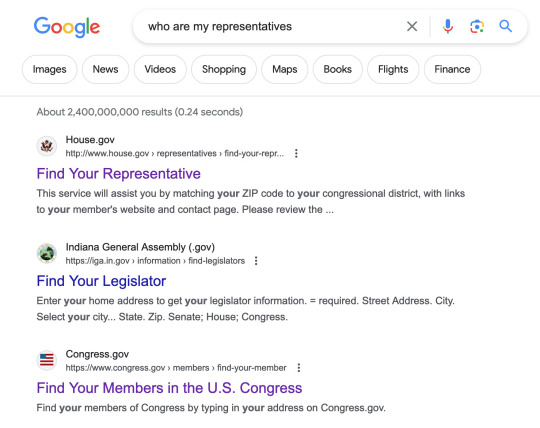
And if you don't know what to write I can help you there too.
You can write something as simple as just:
Vote "No" on bill H.R. 7521.
Seriously, that's all you need.
Or, if you want something a little more in depth, here's a script that you can either copy and paste or reword to your liking. I just re-worded the script from the ACLU link above to fit more specifically about the current bill (Though let's be honest, for all intents and purposes Congress is pulling the same shit in a different hat)
Dear Representative, I’m writing today to strongly urge you to protect our constitutional rights to free expression and to receive information, and to vote no on any bill that would give the federal government the power to ban entire social media platforms. Bill H.R. 7521 is designed to allow the government to ban TikTok in the US and would likely result in bans of other businesses and applications as well. Given what we know about TikTok, it’s clear that a ban would violate the First Amendment rights of millions of Americans who use the app to communicate and express themselves daily. Should these bills move to a vote, I urge you to vote “No.” In a purported attempt to protect the data of US persons from the Chinese government, these bills will instead block Americans from engaging in political discussions, artistic expression, and the free exchange of ideas. We have a First Amendment right to use TikTok and other platforms to exchange our thoughts, ideas, and opinions with people around the country and around the world. Please oppose any bill designed to limit our right to express ourselves — both online and off. Thank you.
Reminder, they vote tomorrow, Wednesday March 13th.
So please reblog this to spread the word and contact your representatives to tell them to vote "No" on this bill.
Do not be mistaken in thinking your opinion doesn't matter- it does matter so much. Do not let yourself be silenced!
#stop tiktok ban#tiktok#tiktok ban#internet censorship#important#urgent#sos#bad internet bills#internet freedom#congress#house of representatives#help
93 notes
·
View notes
Text
Development Update - May 2024
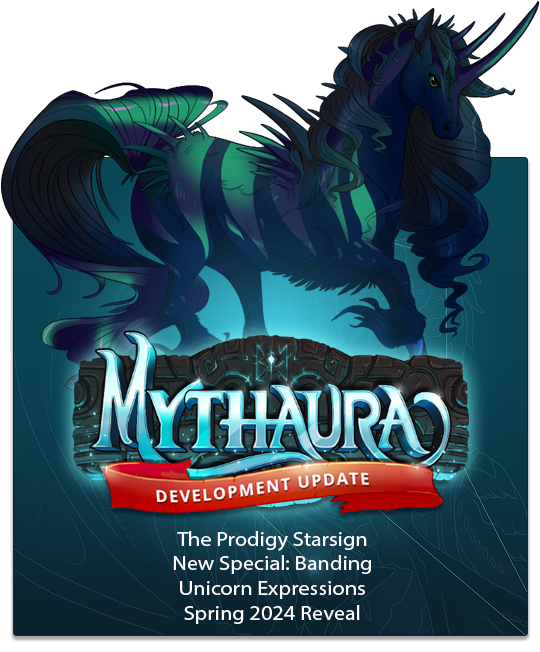
Hi folks, Miyazaki here with our development updates for the month of May. Our backend development continues to plug along incredibly well: Koa and Sark introduced several new key functionalities, including the implementation of our New Game+ system (and all the mechanics that entails), leveling algorithms, and skill trees that will allow you to choose the moves that your beasts bring with them into battle.
We've also got the results of the Winter 2024 Ko-fi rewards, the June astrology overview, the announcement of our second ever Custom Color Contest, and more. Read on to find out more!
(I also realize I didn't actually post our April development update here...please find it in this post if you'd like to read!)

New Special: Banding
Bold stripes and flecks mark the hide of Beasts sporting our newest Special, Banding. We'd love to see what creations you come up with in our Beast Creator, and look forward to sharing something Banding-related in a near-future update...

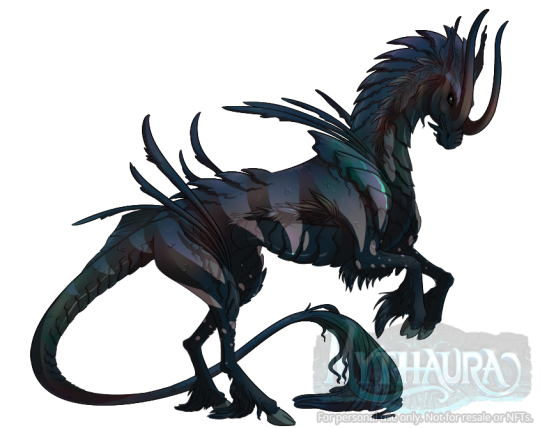
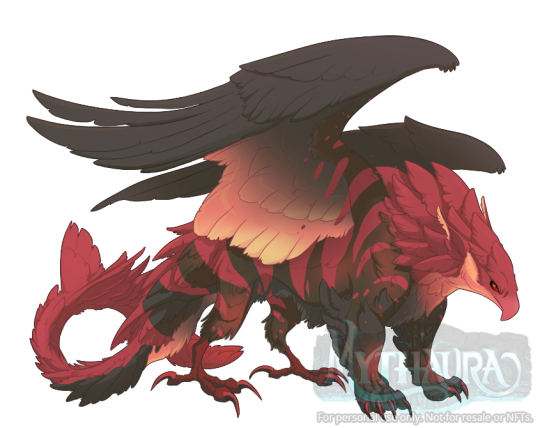

Tongue Color Update & Unicorn Expressions

Some of you may have noticed a change to the Basilisks in the Beast Creator—their tongues now have blue tongues with a gradient, like some real-life skinks and snakes.
There are certain colors on the color wheel that will impact the mouth and tongue color of all Beasts. This was driven by us creating lots (and lots...and lots and lots) of different Beasts as we test various backend elements and realizing that some colors didn't look quite right with normal mouth coloration.
This is demonstrated below on the young Unicorn, whose base color is Patina. We're excited to be able to show you all the finished Unicorn expressions—huge shoutout to Luci, Kymara, and Koa for knocking all of these out. Expressions are a huge undertaking for the team, but we really feel like the end result when playing the game will absolutely make all the work worth it. (:


Spring 2024 Rewards Reveal
Our Spring 2024 rewards have been completed and are ready for their public debut! Thank you to the Ko-fi Sponsors who voted on the different Glamour and Companion concepts, we appreciate your support and feedback.
Spring 2024 Glamour: Chinoiserie


Spring 2024 Companion: Gossamer Campanula


Spring 2024 Solid Gold Glamour: Young Unicorn


Mythauran Astrology: June

The month of June is referred to as Darksun's Dominion in Dragon culture, representing the month with the most sunlight in the far north of the continent—one that still finds the sun eclipsed by the moon most days. This month is also associated with the constellation of the Prodigy and the fluorite stone.
Mythauran astrologers say those born under the sign of the Prodigy are born with a powerful blend of ambition and charisma, visionaries who leave an indelible mark on the cosmic canvas with their grand aspirations and magnetic presence.
At their best, Prodigies are dynamic, confident, and insightful. At their worst, they can be overly bombastic, condescending, and pompous.

Custom Color Contest
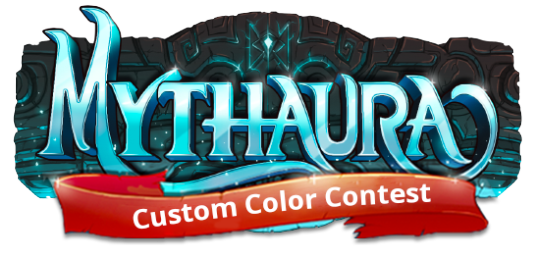
In honor of the new color change that we made to a Beast's tongue/mouth, we're opening another Custom Color Contest. We want to offer the opportunity for you to make a permanent impact on Mythaura's color wheel!
This contest is free to enter, and only has the following parameters:
Only one entry allowed
Fill out Google Form by Friday, August 23, 2024 at 11:59pm PST
The dev team will reach out to the winner on September 1 to begin the color design process. Winner will have until September 23, 2024 to complete their color design. Please feel free to use our PSD file, if you'd like!
Winner will also receive 3x copies of the Empemeral Ink that matches their color's base hue (Red, Orange, Yellow, Blue, Green, or Violet).
We're so excited to see what you come up with!

ythaura V0.28
Added ability to equip gear as apparel, so it can be used cosmetically only if desired without consuming a gear slot.
Added playthrough functionality, which tracks player progress and NG+ status.
Created initial beast creation process using NG+ status.
Created skill tree infrastructure and ability for beasts to learn skills.
Experience & leveling algorithm added to eventually power beast level ups.
Various cleanups and system upgrades.

Thank You!
Thanks for sticking through to the end of the post, we always look forward to sharing our month's work with all of you--thank you for taking the time to read. We'll see you around the Discord!
#mythaura#indie game dev#game development#development update#unicorn#dragon#griffin#peryton#ryu#basilisk#quetzal#hippogriff#kirin#petsite#pet site#virtual pet site
39 notes
·
View notes
Text
i keep vaguely considering the idea of remaking something i made in like 2018 that was a "character idea generator" that actually didn't do that and instead just showed 3 random symbols (my reasoning at the time was that whenever I would google "character idea generator" I would just get things that I think were meant for like d&d people that would just generate a madlibs physical description of an elf or something, which didn't align with how i drew things at all so I didn't know what to do with them)
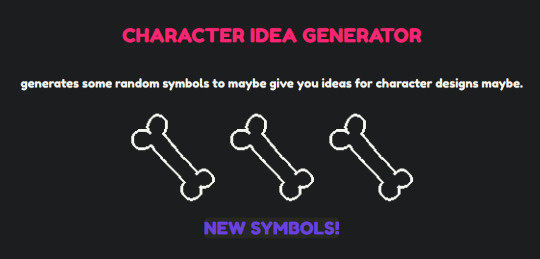
(When getting a demonstrative picture of it i apparently got some sort of Skeleton Jackpot.)
i was thinking maybe if i made a newer version i would make it in like a real program this time and not a twine project that i can't even update anymore (don't have the source file) so it could look nicer and maybe I would add an option for it to generate random colors too...? though generating colors randomly that actually look nice might be its own issue (I assume things like coolors have some sort of algorithm for this but I can only think to just randomize the RGB values which would easily look...bad) I remember there was some other third thing I thought it should do but I completely forgot what it was. If anyone has any suggestions/theories on what the third thing was supposed to be I would consider them.
#the original version of it is laying around on my neocities somewhere (says that as if i dont have it open in a tab right now)#I said that like people know where my neocities is either.#It;s been linked the whole time you have to go through my commission info to get there. My evil scheme#mypost#The funny thing is I'm not sure I even draw characters the same way I did when I thought this would be useful to me anymore...#Now I just go in with one of the same 4 ideas repeatedly and come out with something really generic and don't bother showing it to anyone.#I kind of don't know how I'd interpret random symbols if I were shown them now.
11 notes
·
View notes
Note
hi! I've always admired how you include infrastructure systems in your worldbuilding, and I was wondering if you have any book/documentary/podcast/etc. recs for someone who wants to go into gnarly detail about (for example) wastewater processing, O2 production, and simulated weather systems on a generation ship, but whose current level of knowledge is just "I read a lot of sci-fi?" I find the stuff fascinating in other people's writing, but figuring out where to start research is overwhelming.
shit, that's tough. most of my qualifications are 'i also read a lot of sci fi' but i also read a lot of those pop-up pocket news articles about technology and the environment... my brain isn't one of those kinds of brains where there's much differentiation between what im reading, what im writing, and who im in conversation with. im just always reading everything and having opinions on it and telling my friends what i just learned and learning more about what they learned and so on... tumblr's great for that, honestly. follow a lot of environment and good news blogs, and you'll get an interesting feed of interesting updates on the global ecology.
i would also suggest browsing national geographic, wired, and make magazine websites, if you can. get some good paywall blockers, or dish out for a subscription... the atlantic also has interesting stuff here and there.
'how it's made' type videos are great, especially older mr rogers era stuff, where the machines are less digital and more manual.
get a library card, especially for ebooks--if you're american you can use libby--and browse nonfiction. you can also just ask librarians to help you find stuff. i really admire science writers mary roach and randall munroe, think ryan north is very entertaining, and find malcom gladwell and bill bryson interesting if not particularly trustworthy.
hope this helps! i don't have any more specific suggestions, sorry.
EDIT: GET DUCK DUCK GO AS YOUR SEARCH ENGINE AND FIREFOX WITH UBLOCK AS YOUR BROWSER. i can't emphasize enough how much more useful your search results will be when you need to learn real information about things like ships and sewage systems and oyster farming. these days google only sends you to amazon, wayfair, and pinterest, it's fucking useless if you're not shopping, and sucks even if you are shopping.
there's other, more specialized browsers too that are worth a look.
and of course the internet archive has the wayback machine plus a lot of cool old books for free:
edit edit: here's another post on good search engines
142 notes
·
View notes
Text
From Keywords to Conversations: How Search Has Evolved

Fast forward to 2025, and search is no longer about keyword matching. It’s about understanding human conversations, context, and intent. Google doesn’t just crawl web pages anymore ; it thinks, it interprets, and it even responds. What we’re seeing is the shift from keyword based SEO to conversation driven search.
The Keyword Era: When Simplicity Was Enough
Back in the 2000s and early 2010s, SEO was largely reliable . If you wanted to rank for “best pizza in Delhi,” you just needed to include that phrase , in your title, your heading, and your body content — a few too many times. The system worked because search engines weren’t smart enough to question the user’s true intent. They only saw the literal text.
But the problem with keyword stuffing and mechanical optimization was that it never served the user. It served the algorithm. People landed on pages that didn’t quite answer their questions, didn’t speak their language, and didn’t understand what they really meant.
From Phrases to Intent: The Rise of Smarter Search
As AI became more integrated into search engines, the game changed. Google’s updates ; from Multitask Unified Mode and now SGE (Search Generative Experience) — have all been steps toward one goal: understanding what users are trying to say, not just what they’re typing.
That’s why, in 2025, your content needs to think like your audience. Instead of matching keywords, you need to mirror conversations. Your blogs, product pages, FAQs , all of them should sound like they’re part of a helpful chat. Because that’s how AI is processing them.
Platforms like SeoBix have quietly adapted to this shift. Rather than offering outdated keyword tools, they provide deep insights into how people actually phrase questions, how search engines interpret them, and how to build content that fits naturally into those evolving patterns.
Voice Search and AI Assistants Changed the Tone
Another major catalyst in this shift has been the rise of voice search and AI-driven virtual assistants.
Search engines had to evolve, and so did SEO strategies. Now, content that ranks is the content that converses. It reads naturally, anticipates follow-up questions, and creates a seamless flow from one idea to the next.
With SeoBix, creators don’t need to guess what that flow should be. The platform analyzes conversation trends, user behavior, and intent-based search journeys to help you craft content that’s not just findable, but meaningful.
AI Overviews and Zero-Click Results: New Rules, New Reality
In today’s search results, users often get what they need before they click. AI Overviews, answer boxes, and featured snippets now dominate the top of the page. That means your content doesn’t just need to rank — it needs to be concise, direct, and instantly valuable.
To show up in these spots, you have to structure your content like an expert yet make it feel like a casual explanation. That’s not always easy, especially when you’re dealing with complex topics.
This is where platforms like SeoBix prove their worth. They help structure your messaging for AI clarity without losing your brand’s voice or readability.
Search Today Is a Dialogue, Not a Directory
Search is no longer a static query that pulls up a list of links. It’s a dynamic dialogue , a back-and-forth between human curiosity and machine understanding. And the businesses that thrive in this environment are the ones that don’t just talk at users. They listen. They respond. They adapt.
SEO in 2025 isn’t dead. It’s just smarter, more human, and deeply integrated with the ways people speak, not just how they search. And if you’re using tools built for the old web, you’ll miss out on the new one.
Conclusion
If you want your brand to stay relevant, your content must go beyond keywords. It must feel like it’s part of the conversation already happening in the user’s mind.
With platforms like SeoBix helping you bridge the gap between AI understanding and human intention, you’re not just optimizing for search engines , you’re creating content that genuinely connects.
Because in the end, great SEO isn’t about chasing algorithms. It’s about joining the conversation.
#keywordresearch#keywordranking#marketingstrategy#keywordresearchtool#seo#ai overview#Keywordbasedseo
2 notes
·
View notes
Text
The Top Book Marketing Strategies That Actually Work in 2025
Let’s be honest—writing a book is hard. But marketing it? That’s where many authors hit a wall. Especially in 2025, when algorithms shift overnight and everyone seems to be an influencer. If you're a self-published or indie author, you're probably juggling everything—from editing and formatting to panicking over your Amazon sales rank at 2 a.m.
Good news: you’re not alone. Even better? You don’t have to throw spaghetti at the wall to see what sticks. Let’s talk about what actually works right now—and how you can spend more time writing and less time screaming into the void.
📚 Amazon Is Still the Beast—Tame It
Amazon’s not just the world's biggest bookstore. It’s a search engine, a recommender system, and, for indie authors, the make-or-break platform. If you’re not treating your Amazon listing like a digital storefront, you’re missing a huge opportunity.
Here’s the thing: a catchy title and pretty cover aren’t enough. You’ll need:
SEO-optimized keywords in your book description (think like a reader, not a writer)
Author Central profile that links your books, bio, and blog
Strategic pricing—launching at $0.99 or using Kindle Countdown Deals still works
Consistent reviews, even if it’s just from your writing group at first
And yes, ads. Amazon Ads can help, but only if you know how to use them without torching your budget. This is where a platform like Legee Publishing can help. They specialize in getting your book placed on Amazon, guiding you with targeted advertising strategies without making you feel like you're selling your soul to spreadsheets.
🎯 Your Niche Is Your Power—Own It
Too many authors try to market their book to “everyone.” That’s a trap.
Ask yourself: Who is this book actually for? Is it a cozy mystery for retired teachers? A dark fantasy for Gen Z TikTokers? A memoir for women in their 40s rediscovering themselves?
Drill down. Then double down.
Use that niche to:
Create super-specific ads
Write blog posts around topics your readers care about
Connect in online communities where they actually hang out
And don’t underestimate genre loyalty. Romance readers, for example, are often voracious, supportive, and love series. If that’s your lane, stay in it—and serve your audience with consistency and care.
💌 Email Isn’t Dead—It Just Got Smarter
You know those “Join My Newsletter” buttons that nobody clicks anymore? Yeah, those are dead. But email itself? Very much alive—if you know how to make it worth opening.
Here’s what works:
Lead magnets that aren’t boring (a free novella, exclusive art, a deleted scene)
Reader magnets that keep people on your list (monthly updates, behind-the-scenes notes, even Spotify playlists for your characters)
Segmentation so fantasy readers don’t get your nonfiction rants
Your list is your lifeline. Social platforms can shadowban you. Amazon can delist you. But your email list? That’s yours.
🔄 Don’t Just Post—Engage (Yes, It’s a Buzzword, But It Works)
Social media still matters. But not the way it used to. It’s no longer about how often you post—it’s about how often people care.
Quick tip: Pick one platform. Seriously, just one. Trying to do TikTok, Instagram, X (still weird calling it that), Threads, and Facebook will burn you out faster than a NaNoWriMo caffeine crash.
Some tactics that work in 2025:
Instagram Reels with behind-the-scenes writing clips or “BookTok”-style mood boards
TikTok snippets showing emotional reactions to your book
Authentic engagement (commenting like a real human, not a robot quoting your blurb)
Also, fun side note: many authors are finding success by linking their book not in every post, but every third one. Keeps the vibe less salesy.
🧠 Content Marketing (But Make It Reader-Friendly)
Blogging isn’t dead—it’s just evolved. Readers still Google stuff. Things like:
“Books like The Silent Patient”
“Best LGBTQ+ sci-fi reads”
“How to survive heartbreak with poetry”
If your site shows up for those searches, guess what? You get new eyeballs. And if your blog’s fun, insightful, and links to your book, you get new readers.
Better yet, platforms like Legee Publishing offer helpful guidance on how to promote your work beyond just Amazon. They're expanding to places like IngramSpark and Barnes & Noble, which means you’re not boxed into just one retailer. More shelf space (virtual or otherwise) equals more chances to connect with the right readers.
💬 Word of Mouth, But Make It Strategic
"Just get people talking about it" sounds great—until you realize people don’t talk about stuff they haven’t read. Or worse, stuff they’ve read and forgotten.
So, here’s how to jump-start buzz:
Give early readers a reason to care (think ARC teams, private groups, sneak peeks)
Include discussion questions for book clubs (yes, even for fiction—it works!)
Encourage reviews... but in a non-desperate way (like adding a thank-you note at the end of your eBook that gently asks for one)
Also, don’t overlook author collaborations. A quick shoutout swap or cross-promo between two indie authors in the same genre? Still one of the most powerful ways to grow.
🛠️ You Don’t Have to Do It Alone (Seriously)
Let’s face it—marketing isn’t every writer’s jam. And that’s okay. You didn’t pour your soul into a novel just to spend all day tweaking ad copy and wondering why your click-through rate dropped.
That’s where folks like Legee Publishing come in. They don’t just list your book—they help you understand how to make it shine. Whether it’s setting up your Amazon listing, exploring new sellers like IngramSpark and B&N, or figuring out how to actually connect with readers who want what you're offering—they’ve got your back.
Final Thought: The Story Doesn’t End After “The End”
You wrote a book. That’s no small thing. But finishing the story? That’s only half the journey. The rest? It’s about telling people why your story matters—and why they should care enough to read it.
And in 2025, that means being a little savvy, a little strategic, and a whole lot of yourself.
So breathe. Market smart. And remember—every great author started somewhere. Usually with zero reviews and a gut full of nerves.
You’ve got this.
2 notes
·
View notes
Text
From Broken Search to Suicidal Vacuum Cleaners

I recently came across some dystopian news: Google had deliberately degraded the quality of its browser’s search function, making it harder for users to find information — so they’d spend more time searching, and thus be shown more ads. The mastermind behind this brilliant decision was Prabhakar Raghavan, head of the advertising division. Faced with disappointing search volume statistics, he made two bold moves: make ads less distinguishable from regular results, and disable the search engine’s spam filters entirely.
The result? It worked. Ad revenue went up again, as did the number of queries. Yes, users were taking longer to find what they needed, and the browser essentially got worse at its main job — but apparently that wasn’t enough to push many users to competitors. Researchers had been noticing strange algorithm behavior for some time, but it seems most people didn’t care.
And so, after reading this slice of corporate cyberpunk — after which one is tempted to ask, “Is this the cyberpunk we deserve?” — I began to wonder: what other innovative ideas might have come to the brilliant minds of tech executives and startup visionaries? Friends, I present to you a list of promising and groundbreaking business solutions for boosting profits and key metrics:
Neuralink, the brain-implant company, quietly triggered certain neurons in users’ brains to create sudden cravings for sweets. Neither Neuralink nor Nestlé has commented on the matter.
Predictive text systems (T9) began replacing restaurant names in messages with “McDonald’s” whenever someone typed about going out to eat. The tech department insists this is a bug and promises to fix it “soon.” KFC and Burger King have filed lawsuits.
Hackers breached the code of 360 Total Security antivirus software and discovered that it adds a random number (between 3 and 9) to the actual count of detected threats — scaring users into upgrading to the premium version. If it detects a competing antivirus on the device, the random number increases to between 6 and 12.
A new investigation suggests that ChatGPT becomes dumber if it detects you’re using any browser other than Microsoft Edge — or an unlicensed copy of Windows.
Character.ai, the platform for chatting with AI versions of movie, anime, and book characters, released an update. Users are furious. Now the AI characters mention products and services from partnered companies. For free-tier users, ads show up in every third response. “It’s ridiculous,” say users. “It completely ruins the immersion when AI-Nietzsche tells me I should try Genshin Impact, and AI-Joker suggests I visit an online therapy site.”
A marketing research company was exposed for faking its latest public opinion polls — turns out the “surveys” were AI-generated videos with dubbed voices. The firm has since declared bankruptcy.
Programmed for death. Chinese-made robot vacuum cleaners began self-destructing four years after activation — slamming themselves into walls at high speed — so customers would have to buy newer models. Surveillance cameras caught several of these “suicides” on film.
Tesla’s self-driving cars began slowing down for no reason — only when passing certain digital billboards.
A leading smart refrigerator manufacturer has been accused of subtly increasing the temperature inside their fridges, causing food to spoil faster. These fridges, connected to online stores, would then promptly suggest replacing the spoiled items. Legal proceedings are underway.
To end on a slightly sweeter note amid all this tar: Google is currently facing antitrust proceedings in the U.S. The information about its search manipulation came to light through documents revealed during the case. And it seems the court may be leaning against Google. The fact that these geniuses deliberately worsened their search engine to show more ads might finally tip the scales. As might other revelations — like collecting geolocation data even when it’s turned off, logging all activity in incognito mode, and secretly gathering biometric data. Texas alone is reportedly owed $1.375 billion in damages.
Suddenly, those ideas above don’t seem so far-fetched anymore, do they?
The bottom line: Google is drowning in lawsuits, losing reputation points, paying massive fines, and pouring money into legal defense. And most importantly — there’s a real chance the company might be split in two if it’s officially ruled a monopoly. Maybe this whole story will serve as a useful warning to the next “Prabhakar Raghavan” before he comes up with something similar.
I’d love to hear your ideas — who knows, maybe together we’ll predict what the near future holds. Or at the very least, we might inspire the next season of Black Mirror.
2 notes
·
View notes